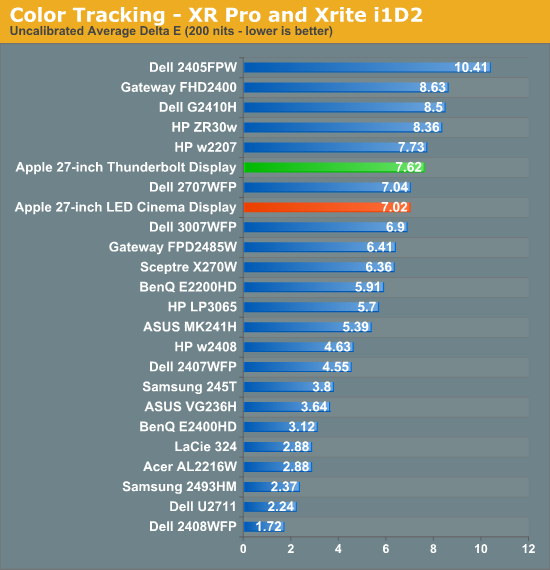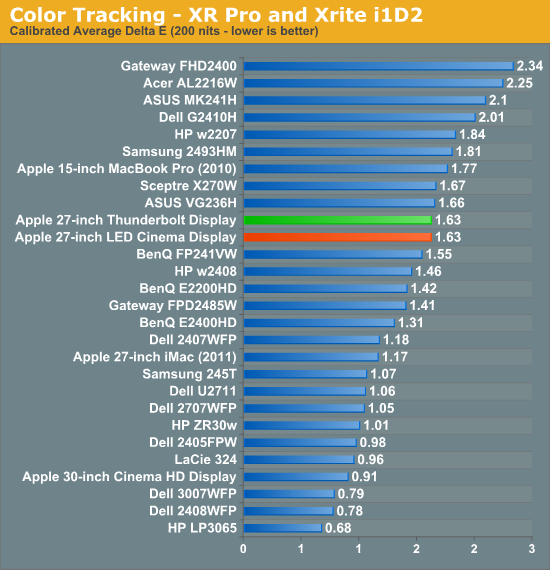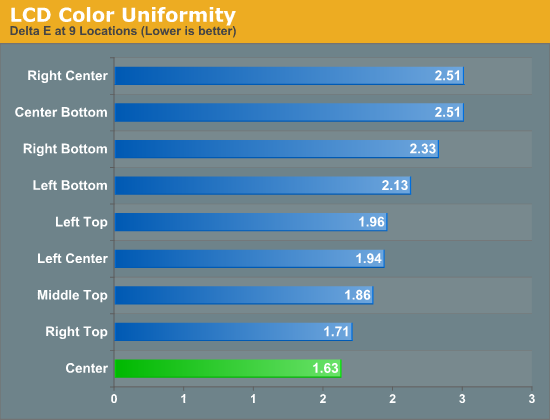The Apple Thunderbolt Display Review
by Anand Lal Shimpi on September 23, 2011 2:56 AM EST- Posted in
- Displays
- Mac
- Apple
- Thunderbolt
- Thunderbolt Display
Display Testing
With all of the extra connectivity there is to test with the Thunderbolt Display we can't forget the actual panel testing. Thankfully this part is pretty simple, the display characteristics are near identical to the 27-inch LED Cinema Display we reviewed last year.
Color Quality
We report two main quality metrics in our display reviews: color accuracy (Delta-E) and color gamut. Color gamut refers to the range of colors the display is able to represent with respect to some color space. In this case, our reference is the AdobeRGB 1998 color space, which is larger than the sRGB color space. So our percentages are reported with respect to this number, and larger is generally better.
Color accuracy (Delta E) refers to the display’s ability to display the correct color requested by the GPU and OS. The difference between the color represented by the display, and the color requested by the GPU is our Delta-E, and lower is better here. In practice, a Delta E under 1.0 is perfect - the chromatic sensitivity of the human eye is not great enough to distinguish a difference. Moving up, a Delta E of 2.0 or less is generally considered fit for use in a professional imaging environment - it isn’t perfect, but it’s hard to gauge the difference. Finally, Delta E of 4.0 and above is considered visible with the human eye. Of course, the big consideration here is frame of reference; unless you have another monitor or some print samples (color checker card) to compare your display with, you probably won’t notice. That is, until you print or view media on another monitor. Then the difference will no doubt be apparent.
As I mentioned in our earlier reviews, we’ve updated our display test bench. We’ve deprecated the Monaco Optix XR Pro colorimeter in favor of an Xrite i1D2 since there are no longer up-to-date drivers for modern platforms.
For these tests, we calibrate the display and try to obtain the best Delta-E we can get at 200 nits of brightness for normal use. We target 6500K and a gamma of 2.2, but sometimes the best performance lies at native temperature and another gamma, so we try to find what the absolute best performance could be. We also take an uncalibrated measurement to show performance out of the box using either the manufacturer supplied color profile, or a generic one with no LUT data. For all of these, dynamic contrast is disabled.

Uncalibrated performance remains fairly similar to last year's LED Cinema Display, however once calibrated the Thunderbolt Display is spot on with its predecessor:

As we mentioned earlier, a sub 2.0 delta E is good enough for professional use. Although not perfect the Thunderbolt Display falls within that range for sure.


We measured slightly lower color gamut on the Thunderbolt Display than the original LED Cinema Display, however the result was much closer to the 2011 27-inch iMac. I couldn't visibly tell any differences and Apple indicates that color gamut shouldn't have changed, so it's quite possible that the differences here are due to our colorimeter and not the panel.
Color Uniformity
Now for color consistency, we take our best calibration profile from the very center at 200 nits and test color accuracy at 9 different places around the LCD display in an evenly distributed grid. We’ve shown before that calibration is localized across the display, partly due to the brightness not being uniform, partly due to the discrete nature of the display itself.

The Thunderbolt Display was fairly uniform across its surface, something we noticed in reviewing the 27-inch LED Cinema Display last year. Uniformity is actually better on this panel than the one we reviewed last year, although in both cases I couldn't really tell any differences.
Peak brightness appears down slightly, but so are the black levels which result in a slightly better contrast ratio. Apple is also calibrating these things at the factory now so white points are now set at around 6300K vs. 7100K on the original 27-inch LED Cinema Display.










275 Comments
View All Comments
Constructor - Tuesday, September 27, 2011 - link
No. The former is an interface protocol, the latter a component.
But Thunderbolt can work on a completely different level with GPUs than USB can:
Internal GPUs are usually connected to the CPU through 16 PCIe Lanes, which adds up to 64Gb/s in each direction with PCIe 2. These GPUs also have the necessary power and cooling available for advanced 3D performance.
And at their outputs, they're pumping out substantially more than 5Gb/s for a high-resolution video signal.
USB3 cannot supply an external GPU with enough data throughput to come even close to an internal GPU. The outright horrible inefficiency of the USB protocol may well eat up half of the nominal bit rate again as it has with earlier incarnations. It also has too little bandwidth to tunnel the video output signal from an internal GPU, let alone on top of full-speed data transfers at the same time.
Thunderbolt on the one hand provides at least double the data bandwidth of USB to drive an external GPU if so desired (which might actually be enough for mid-range 3D applications) and with Thunderbolt that is actually the net throughput with next to no overhead, and on the other it piggybacks not just one but even two complete high-resolution video streams onto the same cable at the same time if so desired!
The two are playing in completely different leagues – USB falls far short of what Thunderbolt can do, not just theoretically but in actual practice.
You will never see anything like the Thunderbolt Display with USB3, at least not remotely with the same performance since it is simply not possible.
Sorry, but I think you don't understand what I am talking about. That you may not be able to perceive the latency of your USB mouse with the naked eye is as it should be, but extremely far removed from the micro- or even nanosecond-range latency requirements of many more advanced interfaces (human perception begins only to notice differences starting in the millisecond range, usually even just at tens or even hundreds of milliseconds).
There are good reasons for advanced audio and video interfaces insisting on using FireWire so far and now starting to switch to Thunderbolt. USB has always had extremely bad response latencies which is inherent in its protocol specification. Critics even suspected that Intel had screwed up the USB protocol that badly because they wanted to keep their CPUs busy so they could keep selling faster ones, even though that is probably just a myth... 8-)
Theoretically USB3 could improve on that to some degree (which is a completely different issue from sheer data throughput), but we'll have to wait and see whether that will actually come about.
Constructor - Tuesday, September 27, 2011 - link
Sorry for the screwed-up boldfacing above. Post editing would be really handy there...! B-)AnnonymousCoward - Tuesday, September 27, 2011 - link
You're mixing the topics of GPU processing and the interface to the monitor.Some facts:
-There's no question that USB3 is not suitable for driving high resolution raw video. Throughput maxes out around 3.2Gbps. 1080p60 24-bit requires about 3.6Gbps.
-Thunderbolt just combines the display and data connectors. When comparing this to a USB solution, compare it with USB3+DisplayPort.
-No external connection can saturate 3.2Gbps. No hard drive, no web cam, no sound card, no peripheral. So Thunderbolt provides no benefit in its 10Gbps vs 3.2Gbps ability.
-Thunderbolt gives you few ports and forces you to daisy-chain. And some Thunderbolt devices only have 1 port, meaning they stop the chain. Having 4 USB3 ports in 1 place is more centralized/convenient.
-Intel probably charges $15/chip. Versus $2/chip for USB3 hosts. The cables are also far more expensive. And for what benefit? To combine data and video cables and force you to daisy-chain.
repoman27 - Tuesday, September 27, 2011 - link
Some corrections to your "facts":-Plenty of external devices can saturate USB 3.0. For instance: single current generation SSD's, SSD or HDD RAIDs, 10 Gigabit Ethernet adapters, Fibre Channel adapters, pro video gear, any number of medical or research lab devices.
-No Gigabit Ethernet adapters exist for USB 3.0 yet, so you would be limited to < 320 Mb Ethernet connections for a while.
-No USB to FireWire adapters exist. USB does not support peer to peer transfers the way FireWire or Thunderbolt do, and thus performance drops off dramatically when copying between two devices connected to the same root hub.
-Some USB devices also block a port... actually most do.
-Thunderbolt doesn't actually force you to daisy chain. Although the silicon doesn't exist for them yet, in theory Multi-port Thunderbolt switches are quite possible.
AnnonymousCoward - Tuesday, September 27, 2011 - link
Your points don't apply to 99% of users.-500MB/s SSDs are internal drives. All external drives I'm aware of are platter-based. RAID-away with platters, and you'll still have a hard time hitting 400MB/s.
-10Gb ethernet? Most people don't care about LAN traffic, and hard drives are often the bottleneck anyway at 90MB/s.
-Fiber equipment and pro video gear--1% of users?
You said it doesn't force you to daisy chain; when you buy a CrapBook Pro, you get 1 port. That means you have to daisy chain.
repoman27 - Wednesday, September 28, 2011 - link
"Facts" aren't facts if they're wrong even 1% of the time though. While all of the examples I cited may be corner cases, they are all valid and contradict points which you presented earlier as factual statements.Also note that among the 1% of users that can benefit greatly from technologies like Thunderbolt are quite a few of the folks that create the music you listen to, produce the movies and TV shows you watch, make the products you purchase and use every day, develop treatments for illness, and help us to better understand the world we live in. Even if you resist adoption of new technologies personally, you can still benefit greatly from them.
Apple has long had the philosophy that if you put advanced technologies into consumer devices that the users will find creative and unforeseen ways to exploit these new capabilities. I don't think they're going to give up on this just because you happen to disapprove.
AnnonymousCoward - Wednesday, September 28, 2011 - link
Ok, you are technically right that "No external connection can saturate 3.2Gbps" isn't an accurate blanket statement. It was intended to be effectively true for almost all users. Sure you can make a $5000 RAID array that reaches that. Many people seem to think Thunderbolt offers a speed advantage over USB3 in applications where it doesn't (nearly all applications).You may be overstating Thunderbolt's benefit for that 1%. So it lets you dock a laptop without a normal docking station, or it saves you from plugging in wired ethernet (yet it doesn't save you from plugging in wired analog audio). That isn't going to help any artist do their work. The 1 unique capability I see that it offers, is the bandwidth to download raw video to a PC. But PCIe cards probably already exist that receive HDMI or DP for a computer.
And I have a feeling that if James Cameron had a Thunderbolt-enabled computer and associated equipment, Avatar would have sucked just as badly.
repoman27 - Thursday, September 29, 2011 - link
Believe it or not, there are actually people who can use (and are excited about) the little known already shipping Thunderbolt devices such as: http://store.apple.com/us/product/H7293LL/A/promis...And I'd be willing to venture that your feeling about Avatar constitutes an actual fact.
Mystermask - Sunday, October 9, 2011 - link
Unbelievable how stupid so called "tech enthusiasts" behave when they read the Name "Apple".1. We've been reading the same technophobic "you don't need that" comments in the past about almost any switch Apple made: the replacement of proprietary ports with USB, 5 1/4" floppys with 3", 3" floppys with CD, CDs with DVDs, cell phones with physical keyboards with Multi Touch devices, etc
2. Let the market decide what is needed. E. g. I'm always astonished how software / solutions make creative use of given hardware capabilities. This kind of evolution can never happen when HW vendors only stick to "what 99% of users need today".
3. By your standards, we should stick to old HW (CPUs, GPUs, ATA, PS2, ..) because 99% of all users don't need newer stuff: They surf, write e-mails, watch photos or use bloated Word from time to time. No
Jamezrp - Monday, September 26, 2011 - link
The video's really well done. I'd recommend using some of the YouTube features for links at the end, though it's clear you did this yourself even though the production value is clearly high up there (good camera, good audio, but minimal editing and control). Great stuff.That said, I've been pondering the Bluemic for some time and the quality on this video just sold me. Completely wrong product...I'd love the Thunderbolt Display to go along with my 13" MBA, but I've already got a Dell 2408 and Acer G24 for my PC which takes up my entire deskspace, and don't need the MBA on a bigger display anywhere else.